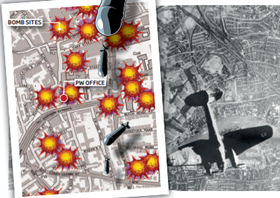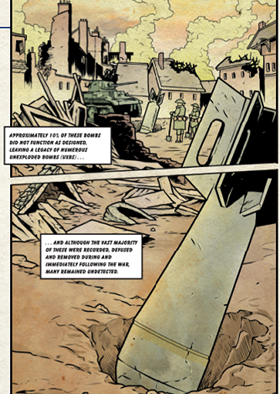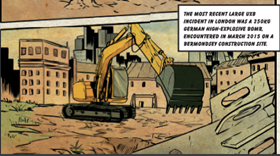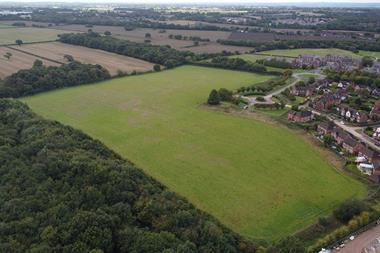More and more unexploded ordnance is being found on UK building sites - is the industry doing enough to tackle the problem or is legislation needed?

The morning of Thursday 12 November 2015 started out like any other for the residents and o ce workers around Spitalfields Market in London.
However, that normality was shattered shortly before 10am when a suspected unexploded Second World War bomb was unearthed as part of archaeological investigations at the former Fruit & Wool Exchange building.
Once workers and local business owners were evacuated as police sealed o the area to investigate further. It was soon established that the ordnance had already exploded and just a shell remained.
The shell was swiftly removed and the site, which is being turned into 320,000 sq ft of new grade-A space by Exemplar, was re-opened. The incident was just one of a number of similar incidents in the capital last year.
In March, families were evacuated in Bermondsey after a shell was dug up on a building site. A similar scenario played out in May when a bomb was found near Wembley Stadium.
In July, shoppers were forced to leave Westfield’s Shepherd’s Bush centre after a bomb was unearthed on a nearby development site.
And in August, residents of Bethnal Green were evacuated after a 500lb shell was discovered under a block of luxury flats.

The Second World War ended more than 70 years ago, but the threat is not over: the sheer volume of unexploded ordnance in the capital means that people are still at risk today.
In the UK we’ve been incredibly lucky: it is more than 30 years since a device exploded unexpectedly.
In Germany and Austria, however, a number of detonations have caused damage to property and even killed people, forcing the respective governments of those nations to make mitigation against unexploded ordnance – or UXO – mandatory.
Given the increased frequency with which discoveries are being made in the UK, questions are now being asked as to whether or not similar measures should be introduced here.
So just how big is the problem and how effective are the property industry’s protocols for dealing with it?
The short answer to the first question is big. Between 1940 and 1945, around 190,000 bombs were dropped on London, resulting in the deaths of 29,000 people.
Experts estimate that approximately 10% of these bombs failed to detonate. Since the end of the war, many of these have been cleared or safely built over.
However, the growing demand on space in the UK’s major cities has accentuated the risk factor.
Shallow foundations
“A lot of urban areas were quickly rebuilt after the war,” says Philip Norville, head of business development – UK land at Dynasafe BACTEC.
“These new buildings were often relatively low rise with shallow foundations. Now we’re constrained in terms of the amount of land we’ve got, so buildings are going higher and equally they’re more sophisticated, so the foundations are inevitably going much deeper and we are moving into areas that weren’t necessarily cleared after the war.”
Norville thinks incidents of this nature are happening more frequently because of the sheer intensity of development – particularly in the capital.

“During 2014-15, seven Second World War bombs were found in London and they were pretty much all on projects where, for example, a 10-storey building was being replaced by a 20-storey building and the foundations were twice as deep, so all of a sudden they were going into a zone that was never cleared,” he explains.
Dynasafe BACTEC, which celebrates its 25th anniversary this month, is a leading UK ordnance expert and offers a wide range of services to property clients ranging from undertaking due diligence on development sites through to detonating ordnance in situ or even removing it and detonating it in a specialist truck that has an inbuilt blast-proof chamber.
One of the products it offers is BombRisk.com – an online unexploded ordnance risk assessment that costs £175 plus VAT.
BombRisk, a joint venture between Dynasafe BACTEC and mapping expert FIND Maps, which launched three years ago, includes a wide range of information on ordnance, such as local authority bombing records and Imperial War Museum records.
Croydon assessment

Property Week commissioned Dynasafe BACTEC and FIND Maps to run a BombRisk assessment of the area immediately surrounding PW’s Croydon office.
In addition to exploring the possibility of bombs being dropped in the vicinity, it also factored in aspects such as whether or not there were military airfields or bombing decoy sites within 10km.
The report suggested there were “significant potential sources of UXO” in close proximity to the site and recommended further research be undertaken to determine more about these sources. It also determined there was a medium to high risk of air-delivered UXBs being found due to bombing density in the area– a bomb strike was recorded within 50 metres of the offices on the London ARP bomb census maps.
In conclusion, the BombRisk preliminary assessment ruled there was a high UXO risk in close proximity to the offices and recommended a full explosive ordnance desktop study be undertaken for the site.
“They collected the information and we georeferenced it, which allowed us to create a matrix on risk,” explains FIND Map’s sales manager Christian Woodhouse.
“So we can look for patterns in historical bomb strikes that were recorded. For instance, if a bomber typically had 10 bombs and you see a pattern on the ground of bomb, bomb, bomb, bomb, and then there is a gap followed by bomb, bomb, bomb, that gap could potentially identify a UXO risk and that risk might be higher than in those other areas because those bombs have already exploded.”
For most of the property industry, a BombRisk report would be the start of the due-diligence process. Norville says that nine times out of 10 the company can swiftly establish that there isn’t a risk. When a potential risk is identified, ordnance experts would then typically carry out a more detailed on-site risk assessment.
“On site, we don’t look for bombs per se; we look for anomalies,” says Norville.
“All our surveying is done with a range of techniques, but primarily magnetometry, which uses very accurate, highly sensitive metal detectors. If we identify a number of magnetic anomalies within the ground we have to find out what they are and because you can’t determine what an item is until you’ve visually seen it, we initially run the data through specialist software that we’ve developed.”
The software allows the team to rule out some things – for instance a buried shopping trolley, which wouldn’t have the right-sized footprint or be dense enough – or establish that an item needs further investigation. From above ground, it is impossible to establish with any accuracy what lies beneath the earth as some objects such as Calor gas bottles or lengths of steel pipe closely resemble a UXO in size and density.
“If we do find something that we positively identify as ordnance, we assess it to work out its condition: is it stable, is it leaking, is it corroded, is it safe to remove or does it have to be left in situ?” says Norville.
Escalation
At this stage, the incident would be escalated to the police, who in turn inform the army or RAF bomb squad. They then decide whether they need to come out and deal with it or if commercially licensed ordnance experts should deal with the problem.
Typically, if the UXO is in a built-up area, a Ministry of Defence bomb squad would come out as they have the authority to block roads, stop public transport and help to evacuate local residents and workers. If it’s in a more remote area where there is little risk to civilians, the likes of Dynasafe BACTEC will typically be allowed to deal with the problem.

In 1999, the company removed a 50kg unexploded bomb (UXB) during the construction of the ExCeL Centre in London and in 2010, it dealt with a 250kg UXB at Beckton Sewage Works.
Despite its age, a bomb of this size could infliict some serious damage as there is a strong chance the explosive content would still be intact and not have deteriorated thanks to the robustness of the protective shell casings.
“When they’re in the ground and they’ve been there for a long time and you have no external factors acting on them, they really are quite stable,” says Norville.
“It’s when you do something different to them that problems occur. You could be excavating or piling and putting vibrations into the ground. Or you might actually hit it, maybe even a number of times, and it’s not an issue, but then you might hit it just the once and it becomes an issue.”
The property industry therefore needs to take the situation seriously. Yet some don’t appear to be doing so. One UK-based ordnance consultant, who prefers to remain anonymous, cites the example of a recent run-in he had with a developer.
“At the start of the project, they approached me for advice knowing the site was potentially high risk,” explains the consultant.
“So I did some work for them and they said: ‘OK, thank you for that – we’re not going to take your recommendations and we’re going to plough ahead anyhow because we don’t think the risk is as high as you’re making it out to be.’
And then lo and behold a few months later they start finding things and they had to shut the site down for a week while further investigations took place.”
Part of the problem is that many companies don’t factor into projects the cost of undertaking the necessary levels of due-diligence work, he argues. “Some people say we don’t have a budget for it and then you’ve got others who have got a budget, but they ask you to value-engineer the price down.”
It is an incredibly short-sighted approach, he adds.
“We’re not talking about big figures here. You’re looking at maybe tens of thousands of pounds on projects that are worth many millions.”
FIND Maps’ Woodhouse also expresses concern about how seriously some people in the industry appear to be taking the issue.
“The number of reports that get run on BombRisk versus the number of planning applications and development sites there are that would probably be deemed as high-risk locations are way off it’s not what it should be,” he says.
So should legislation be introduced?
At the moment, the UK construction industry uses a set of guidelines drawn up by the Construction Industry Research and Information Association – known as CIRIA C681 – for guidance on these matters, but it’s not legally binding.
The number of reports that get run on BombRisk versus the number of planning applications and development sites there are that would probably be deemed as high-risk locations are way off - Christian Woodhouse
Norville, for one, doesn’t believe that mandatory measures should be introduced, but he does think there needs to be greater awareness of the problem in the UK.
“I meet a lot of clients and people at seminars who say: ‘It’s alright, I’m not doing a job in London so it doesn’t matter,’” he says. “But they forget that Birmingham, Coventry, Bristol, Manchester, Portsmouth, Southampton and Liverpool – all these cities were heavily bombed during the first few years of the war. I think we just need to raise the profile so people can make an educated and informed decision.”
Potential problems
This isn’t an issue that will go away any time soon. There is still a large amount of undiscovered Second World War UXO in the UK on sites where development could take place.
With the Ministry of Defence continuing to sell surplus land to the private sector, new owners may also have to deal with devices left behind by British or allied forces.

Norville has already had to attend to UXOs on former airbase sites that are being converted into solar farms.
The good news is that some members of the property industry have got a firm grip on this issue. Maxwell Shand, development director at Exemplar, which unearthed the piece of ordnance at Spitalfields late last year, says the company was acutely aware of the possibility of finding exploded or unexploded ordnance on the site.
“This is quite common across lots of parts of London and as part of the pre-start preparations we undertook a desktop study of the various Second World War bomb maps for this part of London as well as an on-site probing survey,” says Shand.
“Overall, it is a risk to development, but certainly something that most London developers and contractors are aware of.”
Most, but not all. Some people appear to be ignoring this risk, which could have dire implications.
“If you were buying a piece of land you would consider things such as whether it is contaminated, has radon gas, is a food risk, almost without thinking,” says the ordnance consultant.
“But that doesn’t happen with UXOs. A lot of ordnance is either located in the bucket of an excavator, or found by a site operative who is digging a hole with a shovel, and no one prior to that point had given any thought to ordnance on the site whatsoever. That’s slightly alarming.”
More than that, if the issue is not addressed, it could quite literally blow up in people’s faces.






























No comments yet